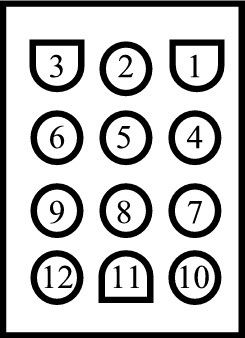Amana Gas Furnace: GULA
Re: Flashing Code 4
Code 4 = Main limit switch (auto-reset) has opened its normally closed contacts, or the Blower Auxiliary Limit (manual-reset) has tripped.
- The control will operate the supply air blower and inducer while the open limit condition exists.
| Qty |
Possible Causes: |
|
Bad Blower Motor or Capacitor |
| 1 |
Bad Control Board |
|
Dirty or Restrictive Air Filter |
|
Clogged Evaporator Coil |
|
High Duct Static |
|
High Gas Pressure |
|
Bad Limit |
|
Blower Speed too Low |
CHECKOUT:
1. Check Limit Circuit
- While the furnace is Flashing Code 4, check for 24VAC across the limit circuit.
- Check for 24VAC between "C" Common and Terminal #1 of the 12-Pin Plug (PK-30).
- Check for 24VAC between "C" Common and Terminal #7 of the 12-Pin Plug (BU-27).
- Power on Both Terminals + Code 4 = Bad Control Board
- Power on One Terminal Only = Open Limit Circuit ⇒ Check Primary Limit (below)
- Primary Limit
- Check for 24VAC between "C" Common and both sides of the Primary Limit.
- Power on Both Sides = Limit OK ⇒ Check Aux Limit (Below)
- Power on One Side Only = Open Limit
- Aux Limit
- Check for 24VAC between "C" Common and both sides of the Auxiliary Limit (in the blower compartment).
2. Check Blower Operation
- While the furnace is operating or Flashing Code 4, check to see if the blower motor is operating.
- Blower Motor Running Normally → Step 3. Check Temperature Rise
- Blower Motor Not Running ⇒ At the furnace control board, check for 120VAC between "CIR-N" and "LO HEAT-H", then between "CIR-N" and "HI HEAT-H".
- 120VAC Present + No Blower = Bad Blower Motor or Capacitor
- No 120V Present = Bad Control Board
3. Check Temperature Rise
- Start the furnace with a call for heat.
- Check the temperature rise across the furnace.
- Compare the actual temperature rise to the rated temperature rise on the furnace nameplate. (typically 40 - 70 deg.)
- Temperature Rise At or Above Maximum → Step 4. Check Air Filter
- Temperature Rise Below Maximum but Limit Trips ⇒ Suspect Bad Limit
4. Check Air Filter
- Remove air filter and recheck temperature rise.
- Temperature rise drops into normal range = Clogged or Restrictive Air Filter
- Temperature rise still too high → Step 5. Check Gas Pressure
5. Check Gas Pressure
- De-energize the call for heat and allow the furnace to cool.
- Energize a call for heat.
- Check the manifold gas pressure.
- 1st Stage Heat
- Natural Gas = 1.7 to 2.3" w.c.
- LP Gas = 6" to 8" w.c.
- 2nd Stage Heat
- Natural Gas = 3.2 to 3.8 " w.c.
- LP Gas = 9" to 11" w.c.
- Pressure Above Maximum ⇒ Adjust Gas Pressure & Re-check Temperature Rise
- Pressure Below Maximum + Still Over-Heating → Step 6. Check Blower Speed
6. Check Blower Speed
- Check the blower motor speed wire attached to the "Lo Heat-H" and "Hi Heat-H" outputs of the control board.
- Red = Low
- Orange = Med Low
- Blue = Med Hi
- Black = Hi
- If possible, increase the Heat blower speed and Re-Check Temperature Rise
7. Check Duct Static Pressure
- Check the return static pressure (in the blower door if possible).
- Check the supply static pressure (between the furnace and evaporator coil if possible).
- High Duct Static = Above 0.5" w.c.
- High Return Static + Low Supply Static = Restricted Return Ductwork
- Low Return Static + High Supply Static = Clogged Coil or Restricted Supply Ductwork
- Compare static on both sides of evaporator coil.
- High Static Entering Coil + Low Static Leaving Coil = Clogged Coil

